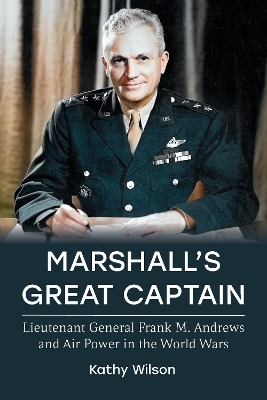
Marshall's Great Captain
Lieutenant General Frank M. Andrews and Air Power in the World Wars
Seiten
2024
The University Press of Kentucky (Verlag)
978-0-8131-9914-6 (ISBN)
The University Press of Kentucky (Verlag)
978-0-8131-9914-6 (ISBN)
On May 3, 1943, dozens of airplanes could be seen flying in and out of Royal Air Force Bovingdon Airfield near London, England. Among the aircraft seen that day was a B-24D bomber named Hot Stuff, which carried the Commanding General of US Forces in Europe, Lieutenant General Frank M. Andrews -the officer charged with formulating a plan to invade the European continent. Speculation was that General George C. Marshall had called Andrews back to Washington, DC, leading many to believe that Marshall had another promotion in store for Andrews. Tragically, Andrews would never arrive. While attempting to land in Iceland, the bomber crashed into the side of a mountain, with no survivors other than the tail gunner; Andrews's personal papers were also destroyed.
In Marshall's Great Captain: Lieutenant General Frank M. Andrews, author Kathy Wilson details Andrews's extraordinary life and career. The first biography dedicated to the namesake of Joint Base Andrews, this book sheds a light on Andrews's crucial role in orchestrating US involvement in World War II, as well as the professional relationship and rapport that Andrews and Marshall shared. Drawing on extensive research, Wilson raises Andrews's legacy to its legitimate place within the annals of both air power and World War II history and posits that there is a high probability that Andrews, rather than Dwight D. Eisenhower, was Marshall's first choice for the office of Supreme Allied Commander. Marshall recounted that Andrews was the only one he had a chance to prepare for such a command.
In Marshall's Great Captain: Lieutenant General Frank M. Andrews, author Kathy Wilson details Andrews's extraordinary life and career. The first biography dedicated to the namesake of Joint Base Andrews, this book sheds a light on Andrews's crucial role in orchestrating US involvement in World War II, as well as the professional relationship and rapport that Andrews and Marshall shared. Drawing on extensive research, Wilson raises Andrews's legacy to its legitimate place within the annals of both air power and World War II history and posits that there is a high probability that Andrews, rather than Dwight D. Eisenhower, was Marshall's first choice for the office of Supreme Allied Commander. Marshall recounted that Andrews was the only one he had a chance to prepare for such a command.
Introduction
Prologue
Johnnie and Her Cavalryman
America's Fledgling Eagles, 1917-1934
GHQ Air Force, 1934 -1939
The Long-Range Bomber
A Higher Calling (G-3, Operations)
American Lake
Cairo and the ETO
The Final Flight
Epilogue
Acknowledgements
Appendix
Notes
Selected Bibliography
Index
| Erscheinungsdatum | 03.04.2024 |
|---|---|
| Zusatzinfo | 29 b&w illustrations |
| Verlagsort | Lexington |
| Sprache | englisch |
| Maße | 152 x 229 mm |
| Themenwelt | Literatur ► Biografien / Erfahrungsberichte |
| Sachbuch/Ratgeber ► Geschichte / Politik | |
| Natur / Technik ► Fahrzeuge / Flugzeuge / Schiffe ► Militärfahrzeuge / -flugzeuge / -schiffe | |
| Geschichte ► Allgemeine Geschichte ► 1918 bis 1945 | |
| Geschichte ► Teilgebiete der Geschichte ► Militärgeschichte | |
| Sozialwissenschaften ► Politik / Verwaltung | |
| ISBN-10 | 0-8131-9914-X / 081319914X |
| ISBN-13 | 978-0-8131-9914-6 / 9780813199146 |
| Zustand | Neuware |
| Haben Sie eine Frage zum Produkt? |
Mehr entdecken
aus dem Bereich
aus dem Bereich
von der Machtergreifung bis zur Gründung der Vereinten Nationen
Buch | Softcover (2023)
Motorbuch Verlag
CHF 38,90


